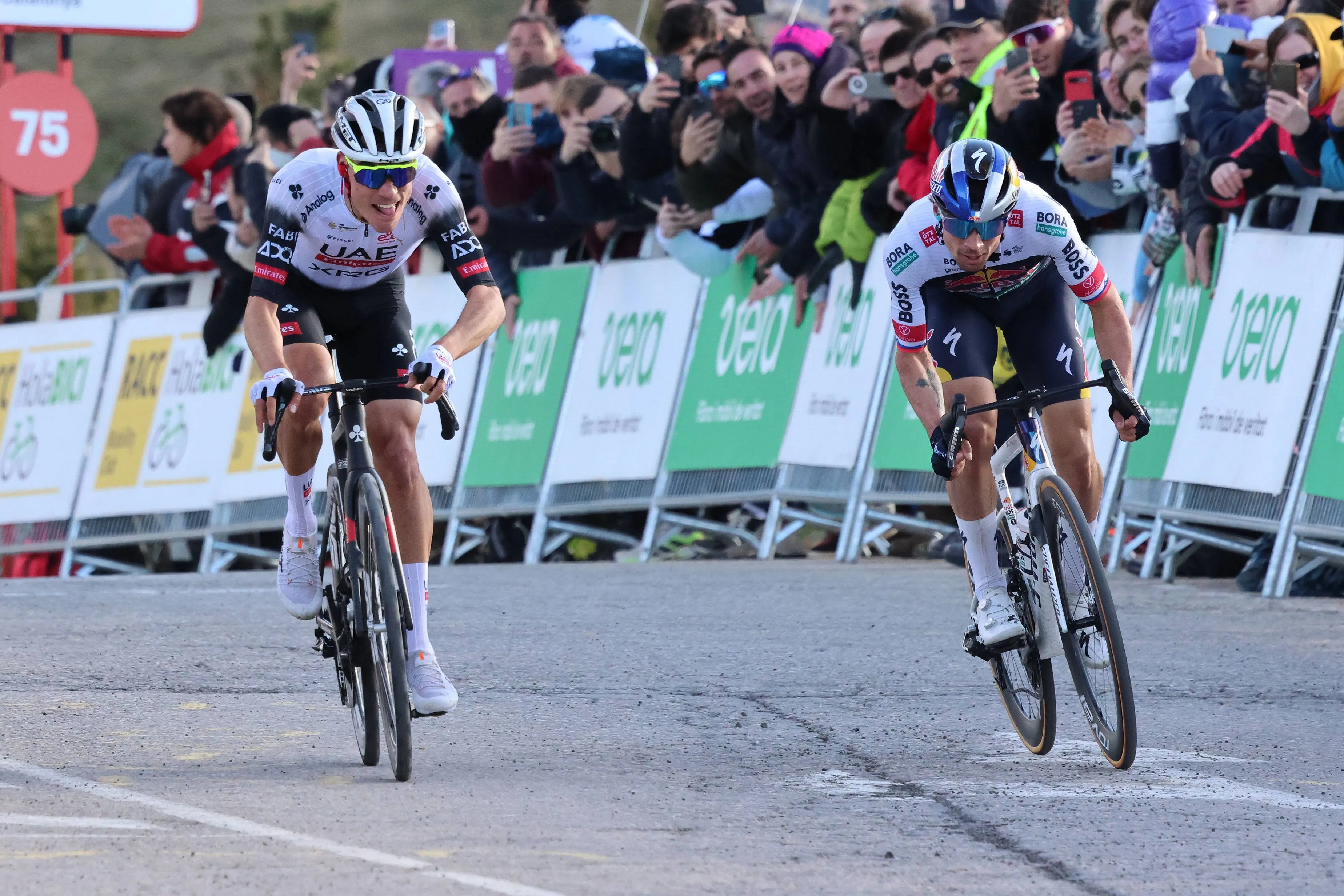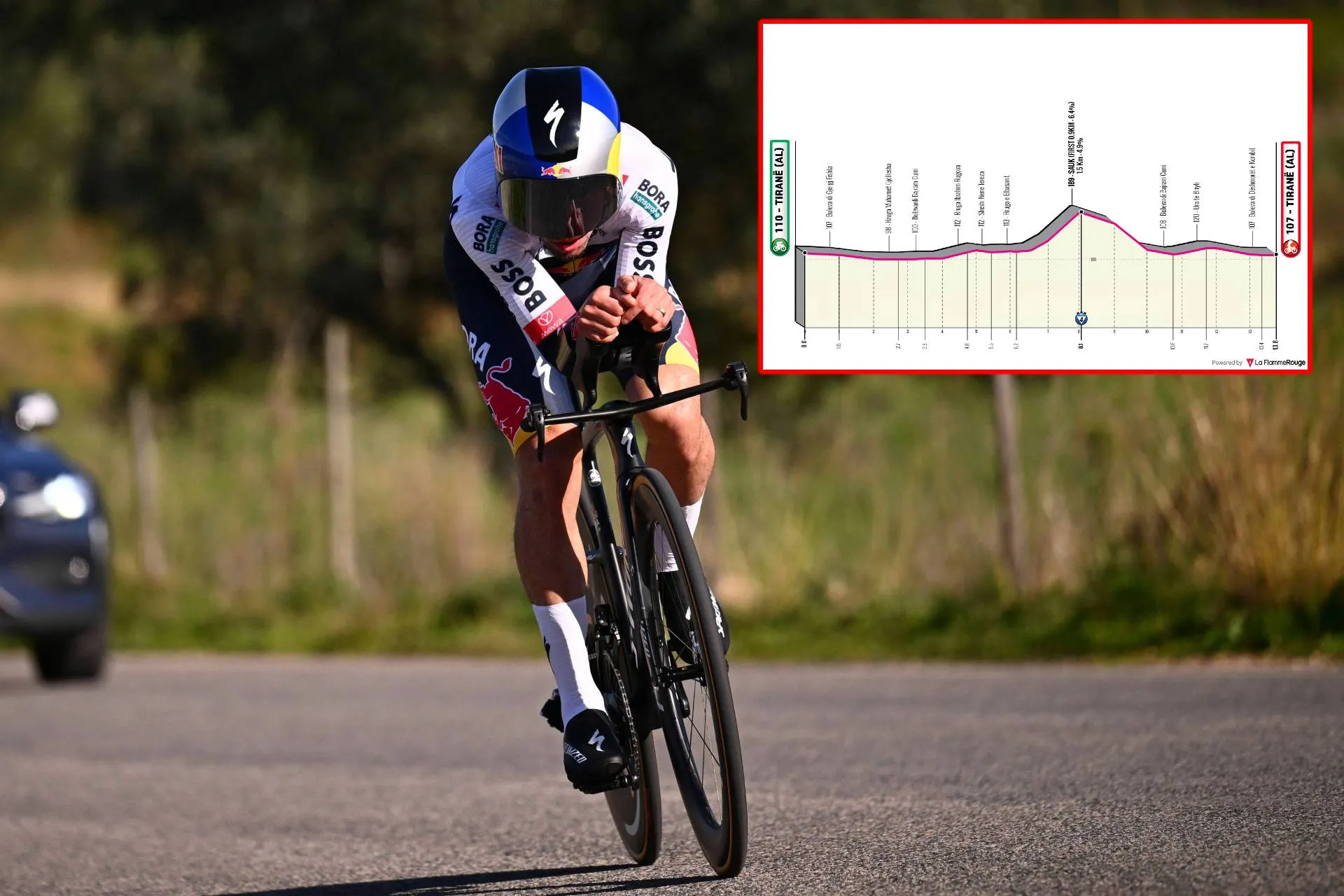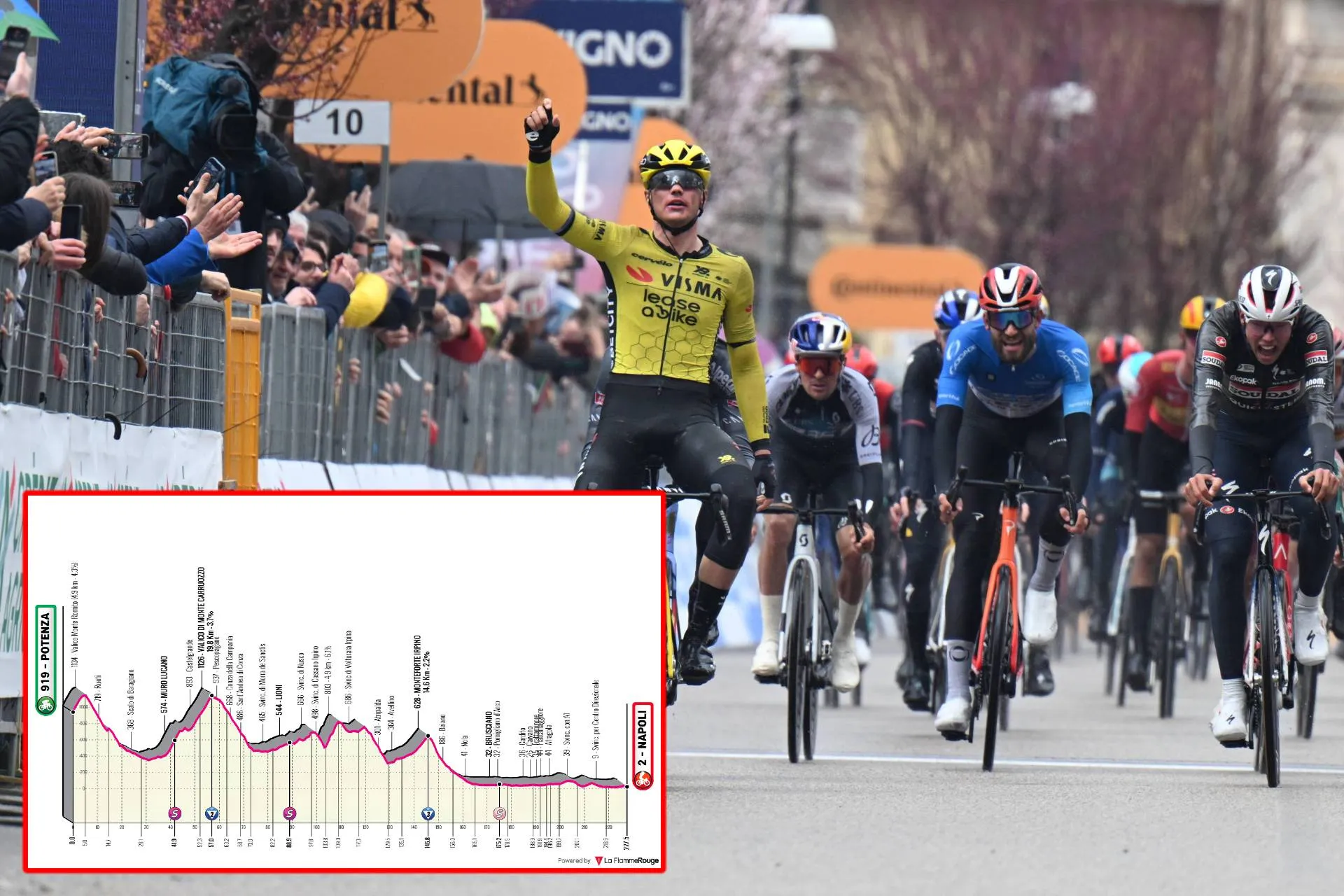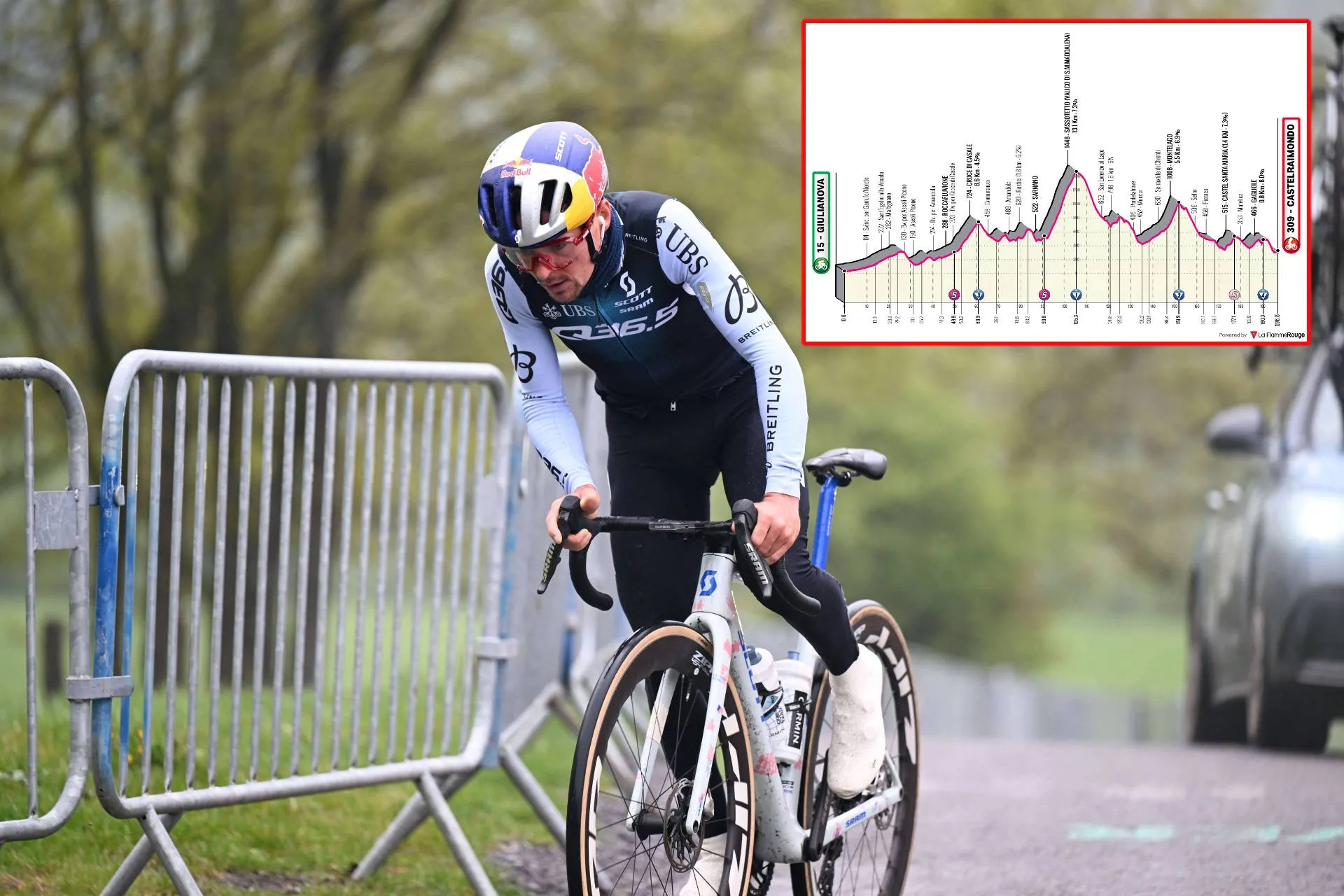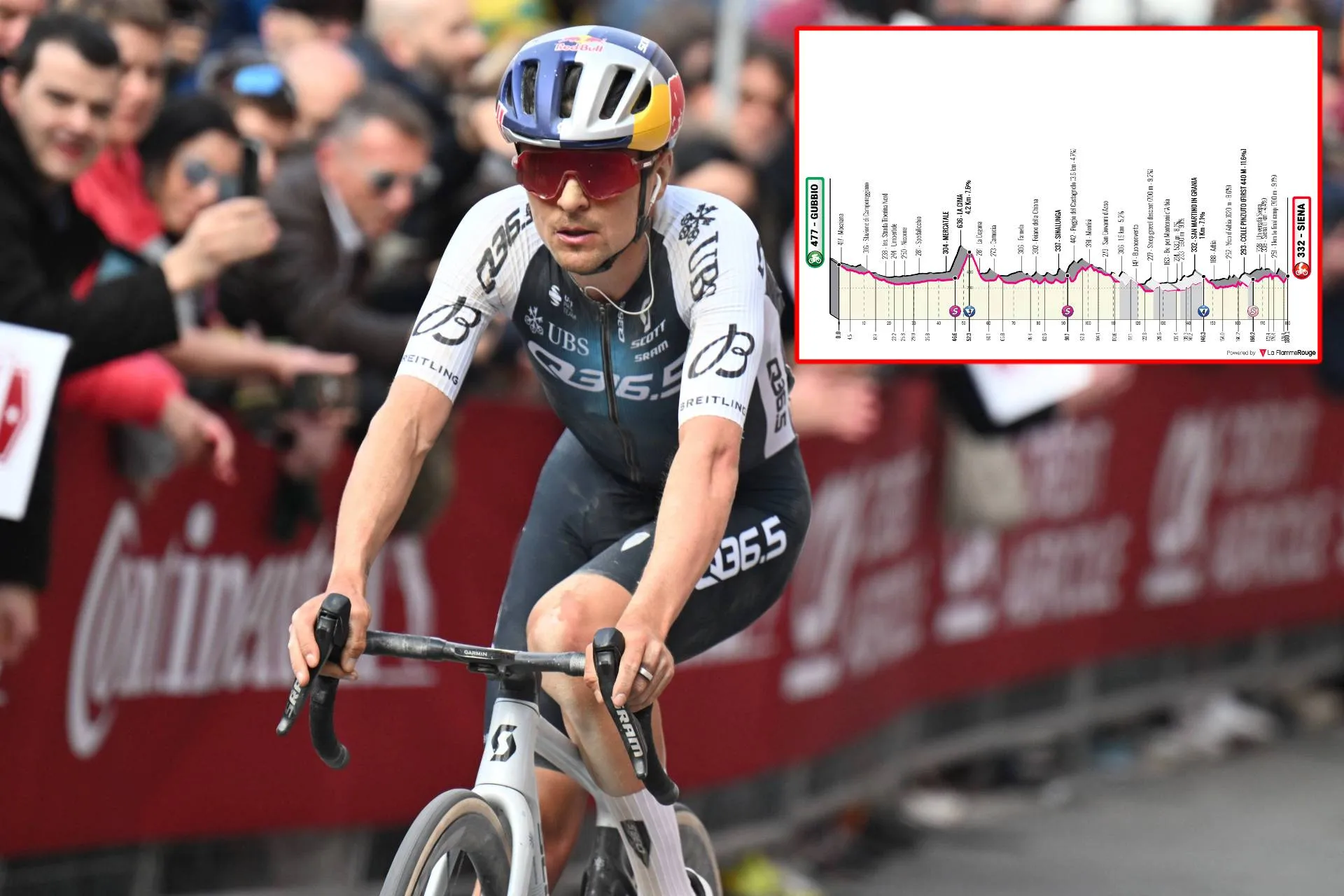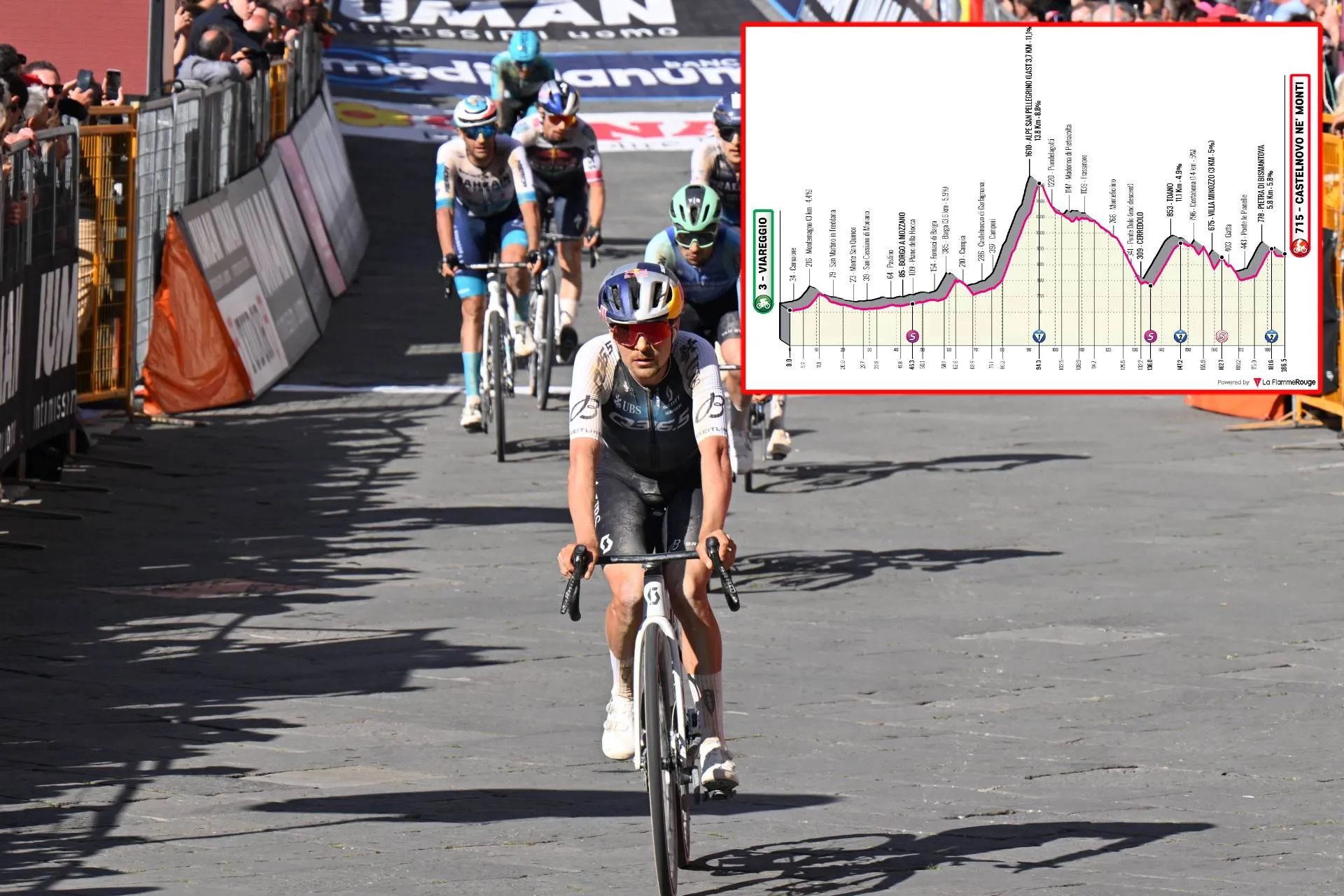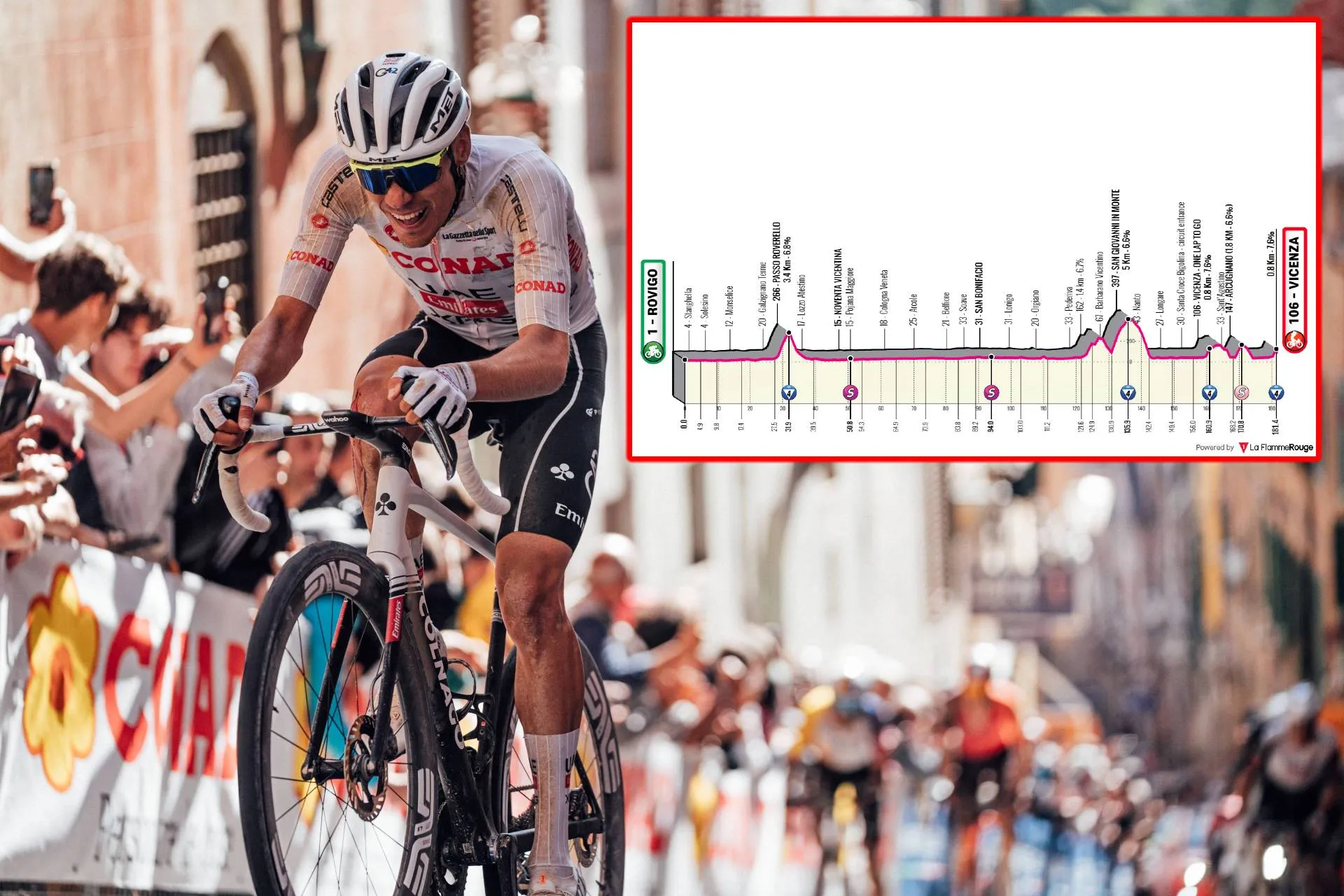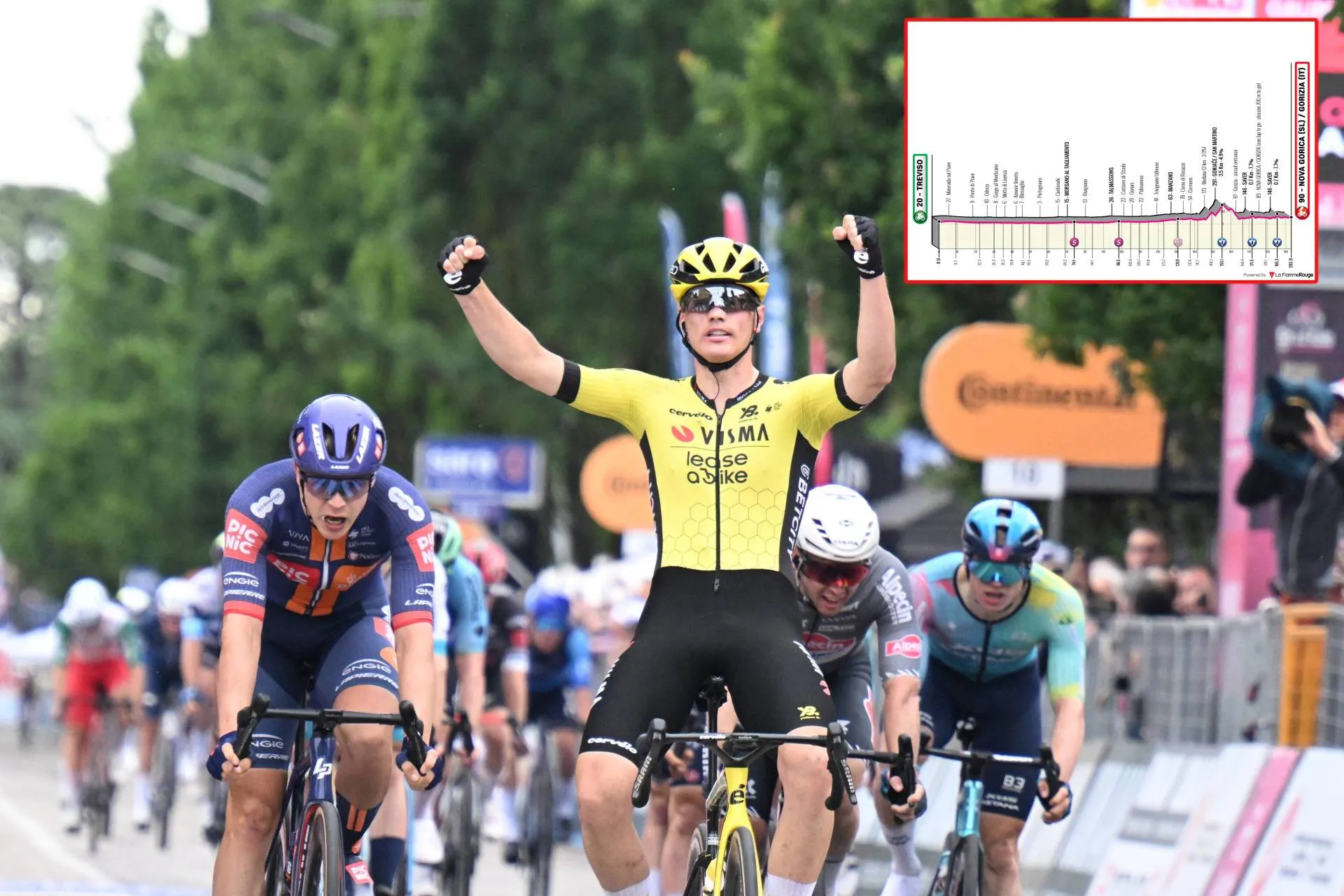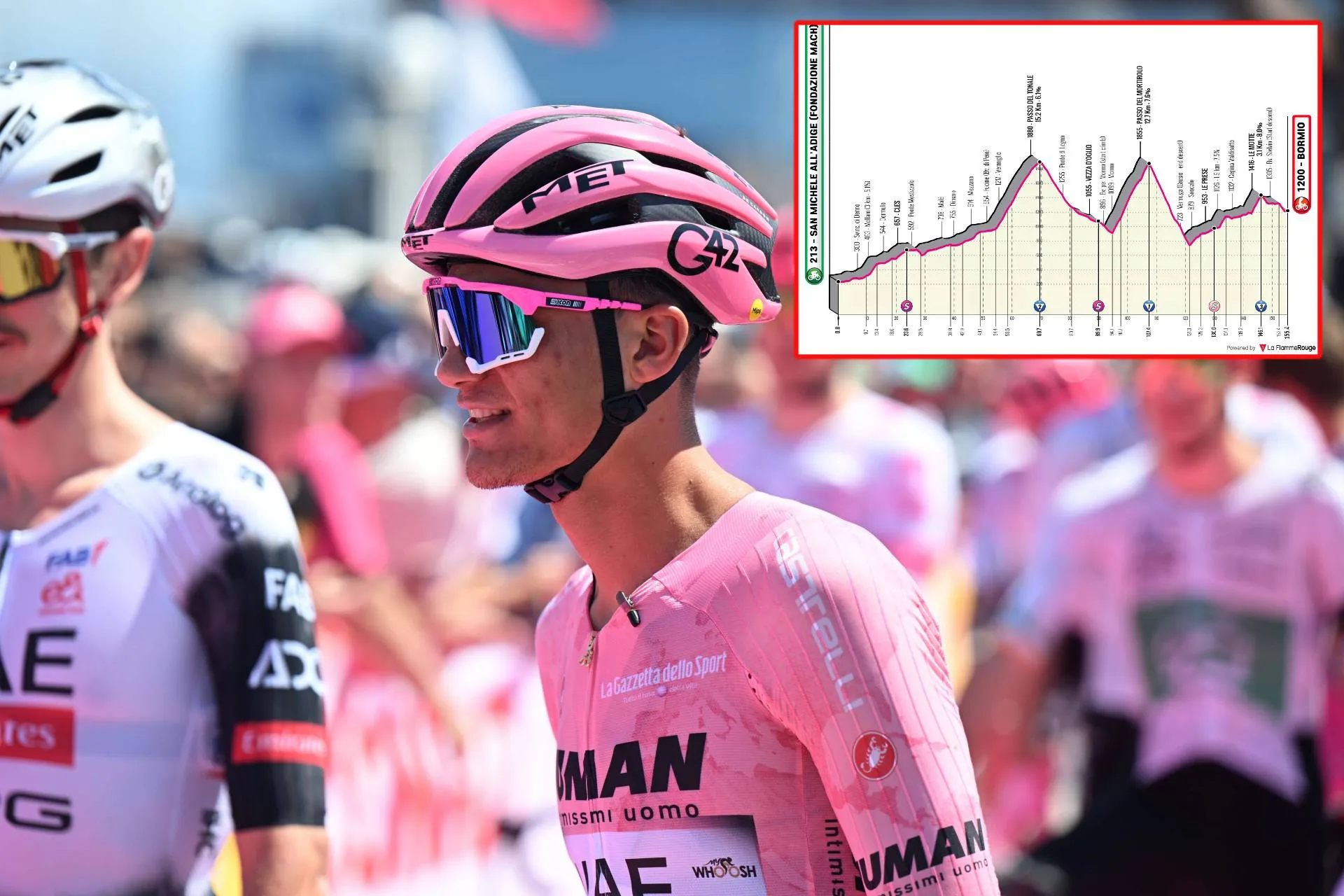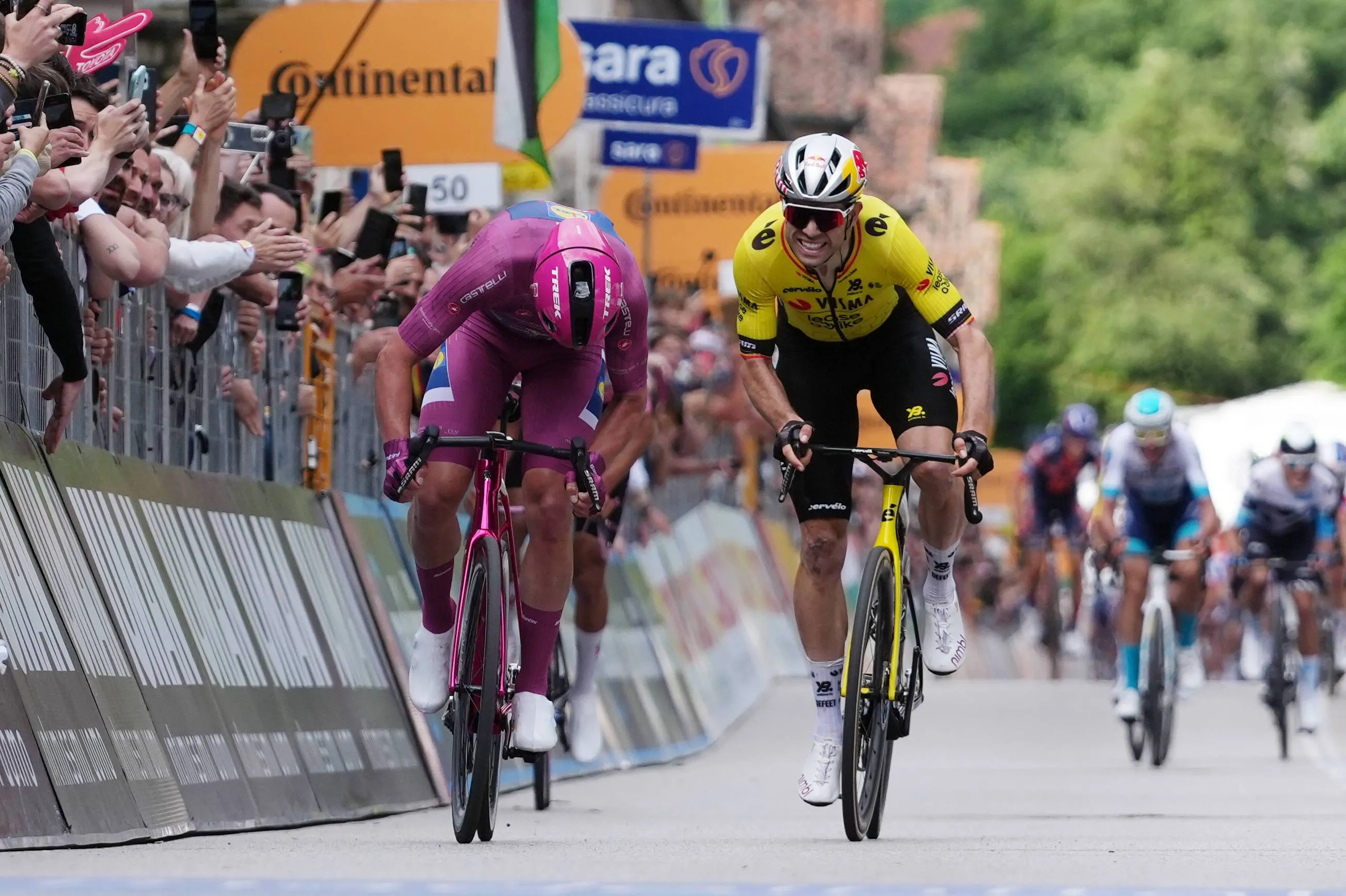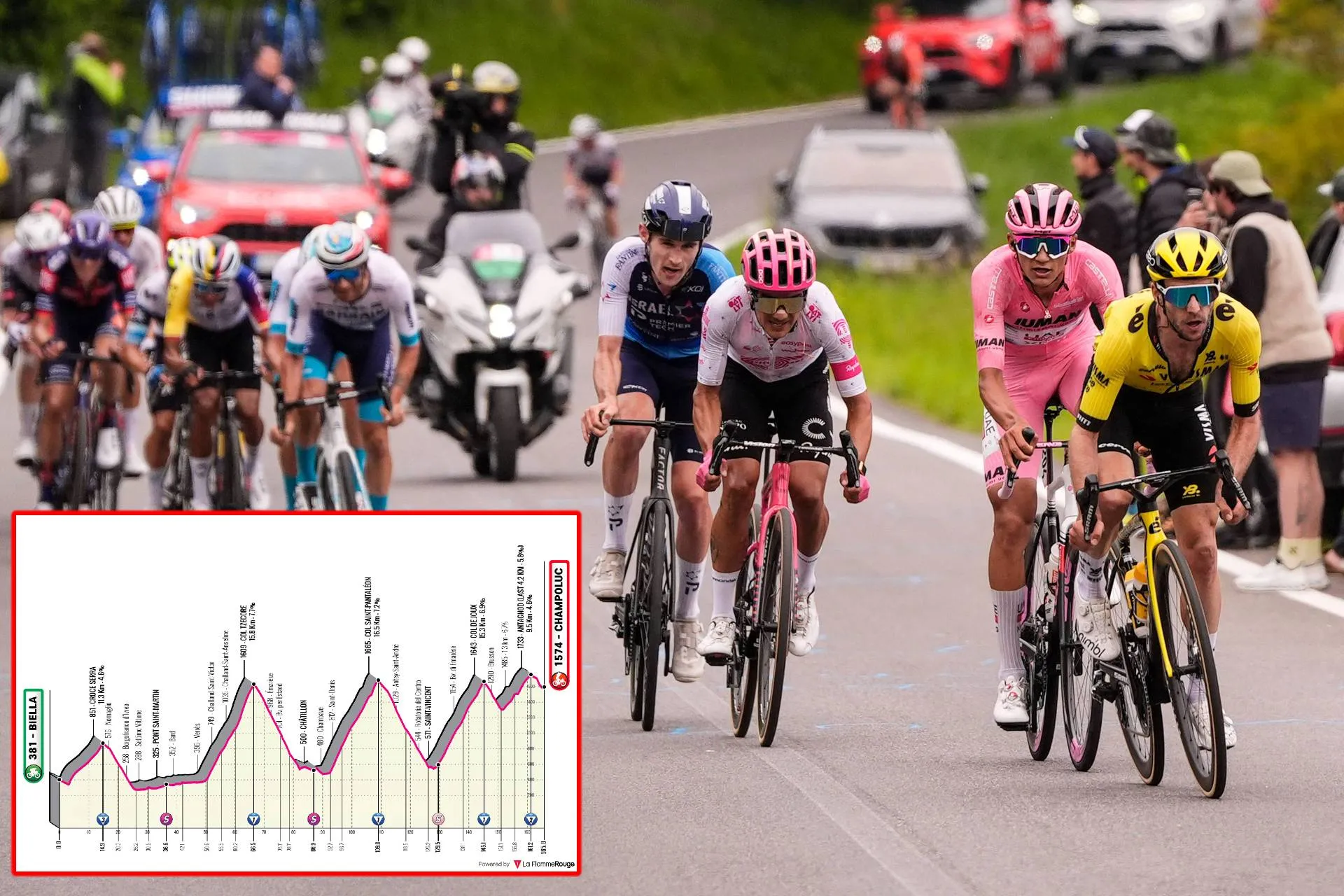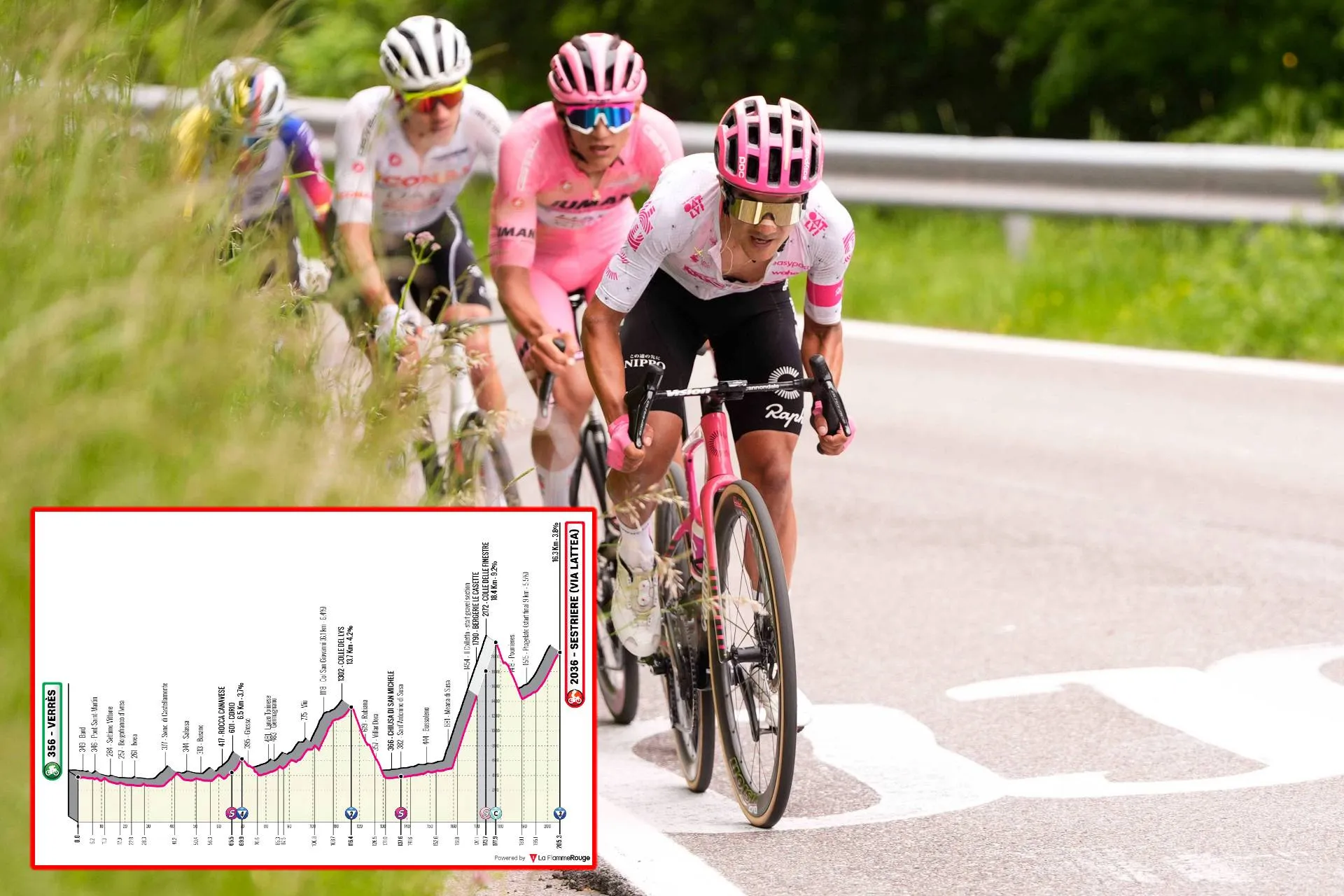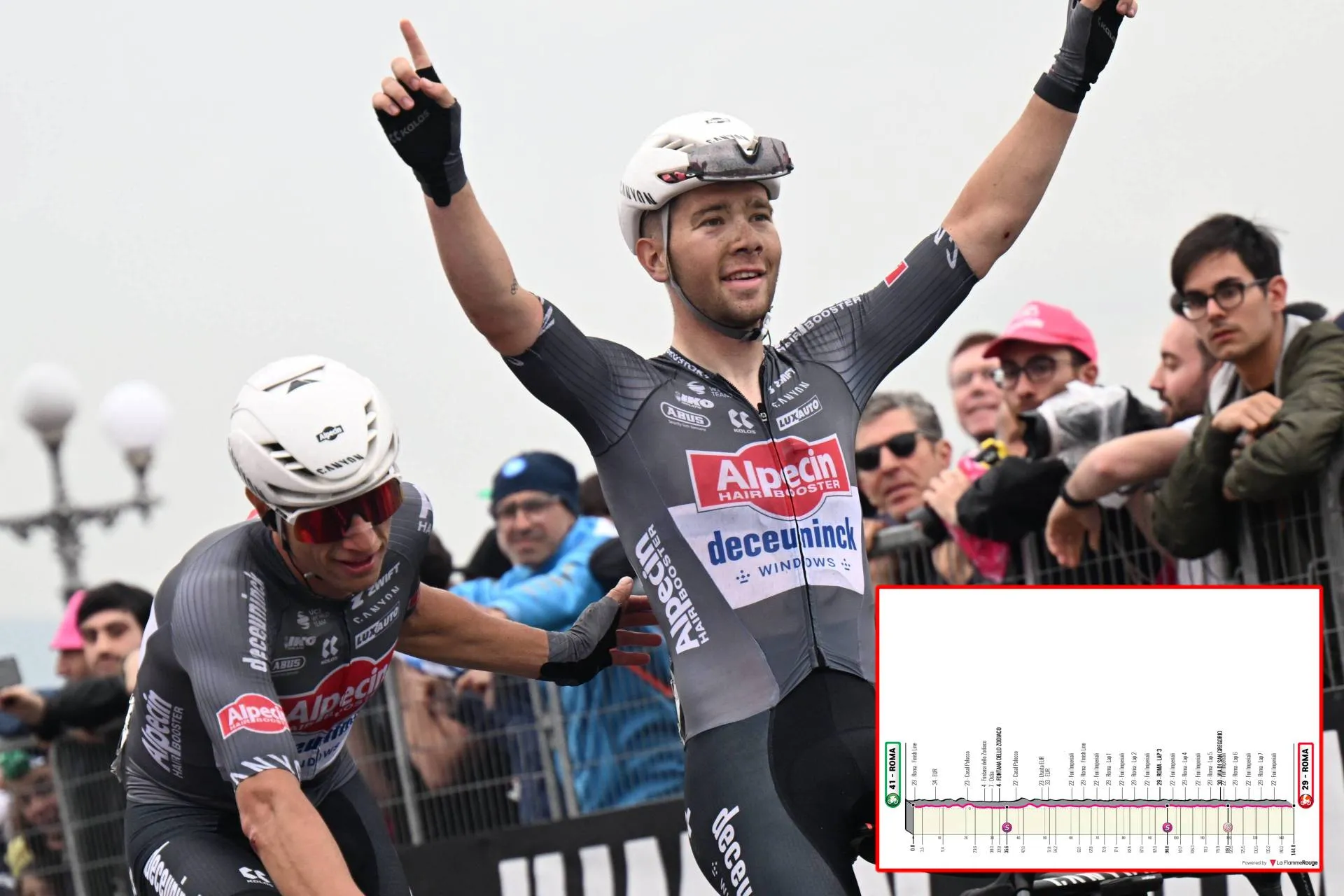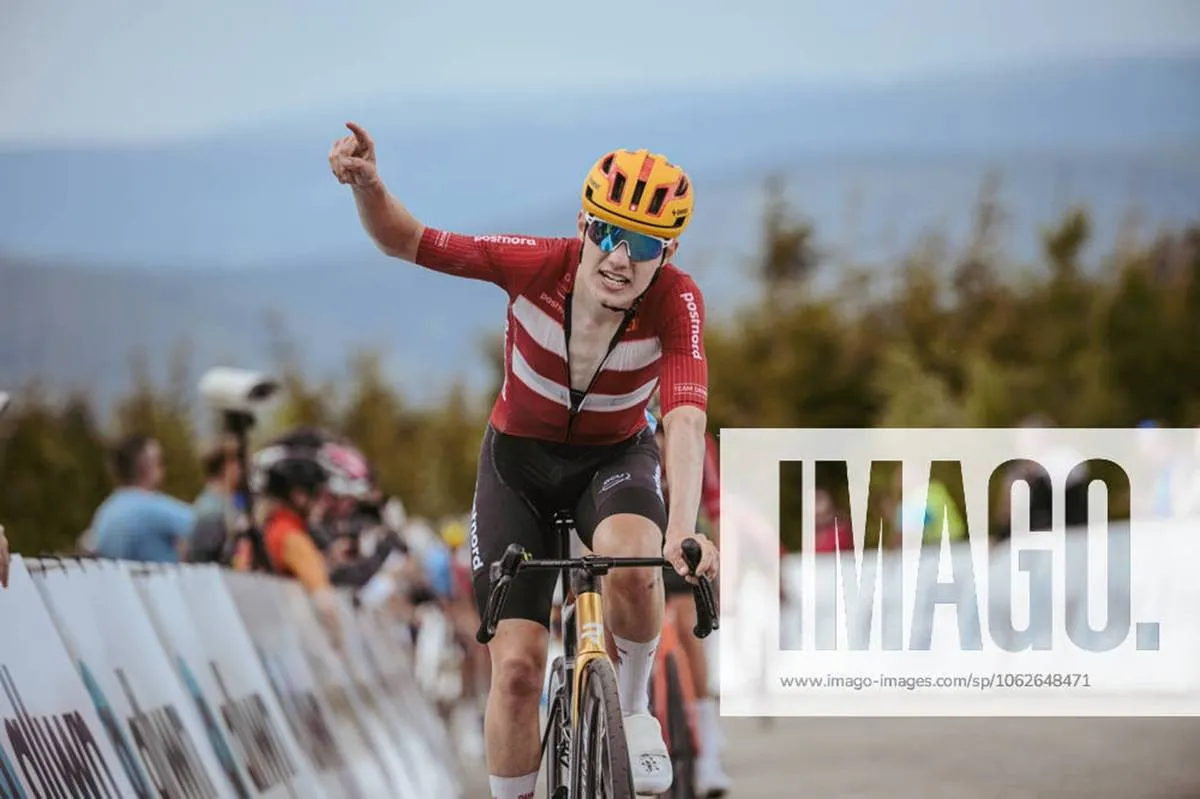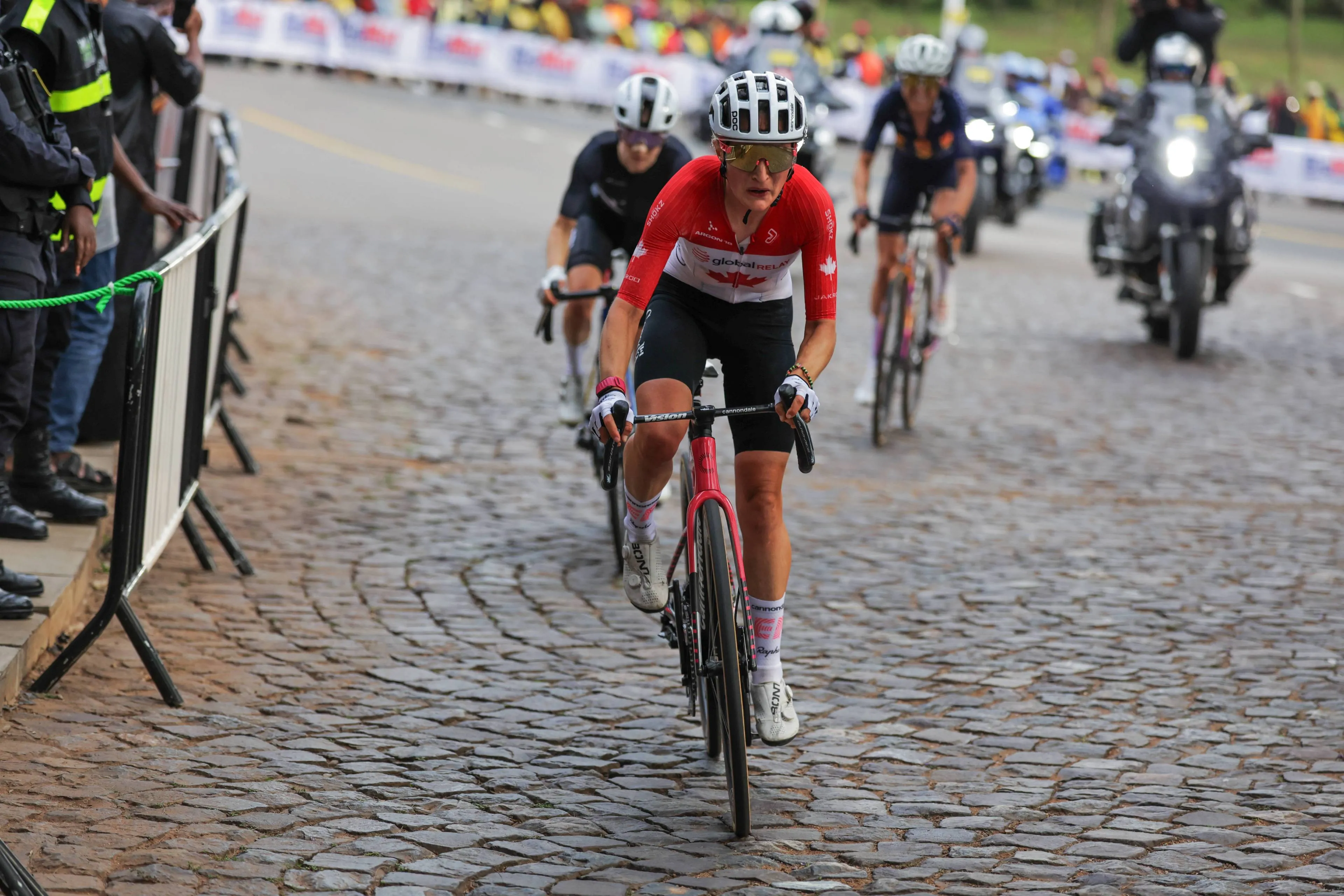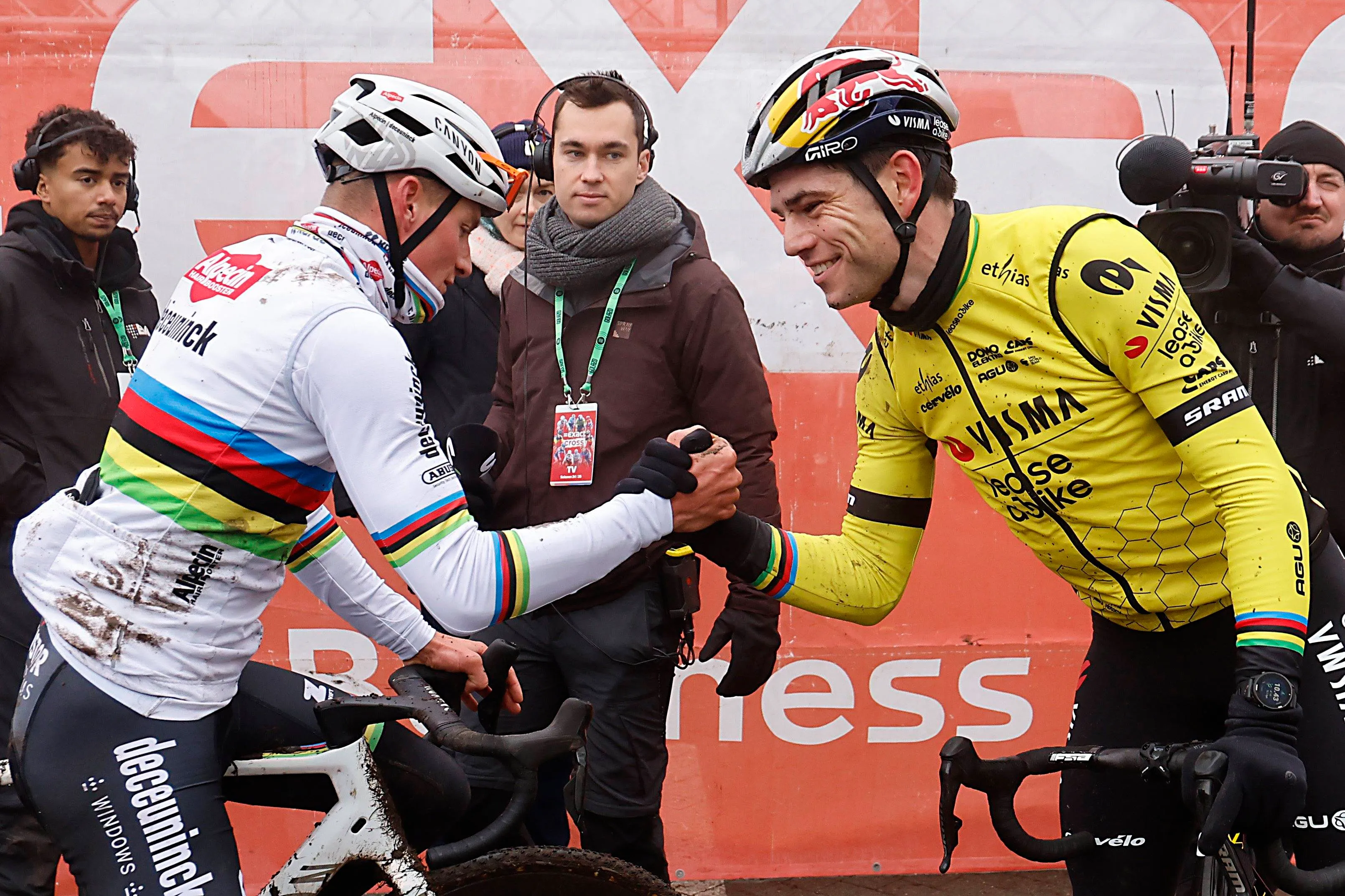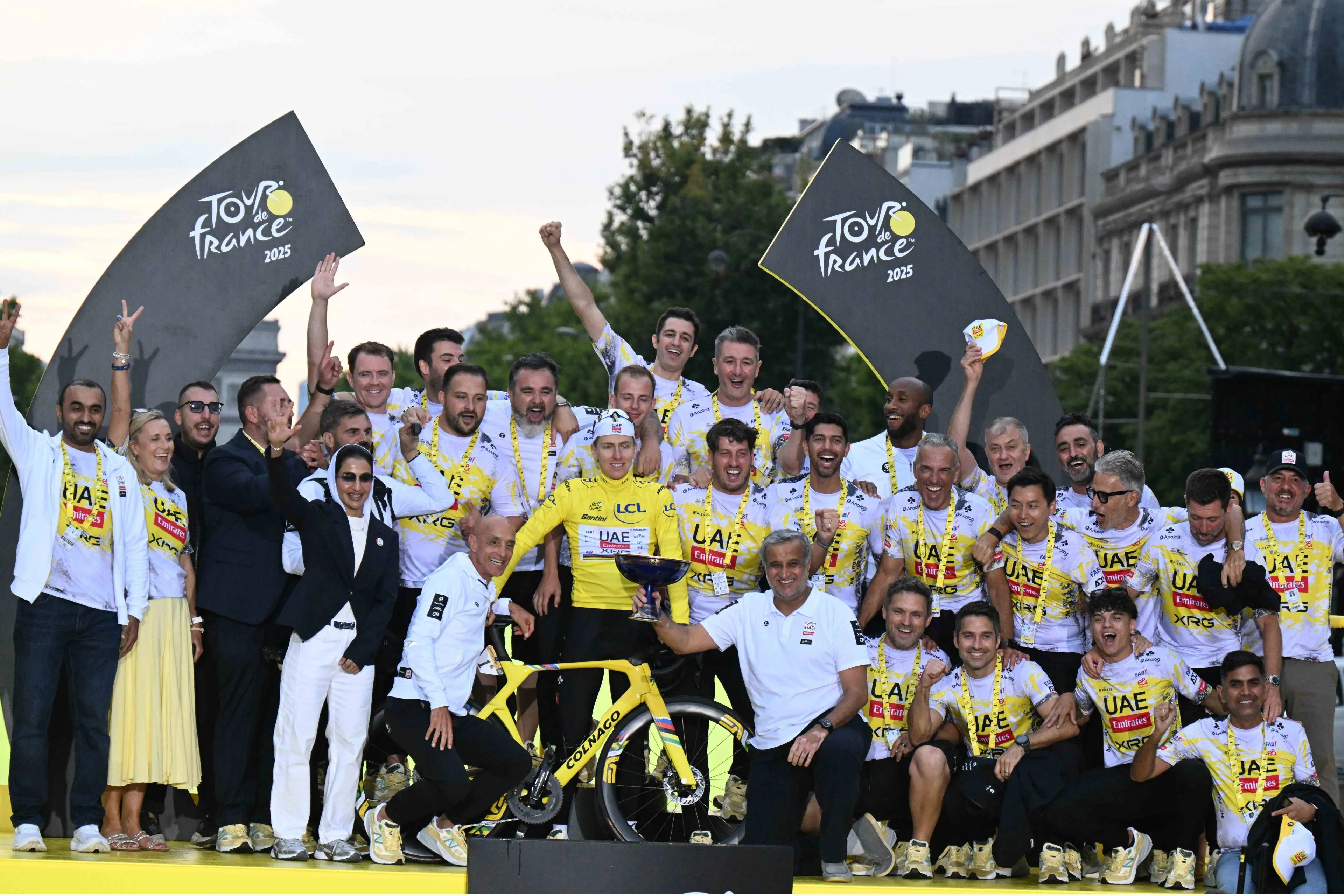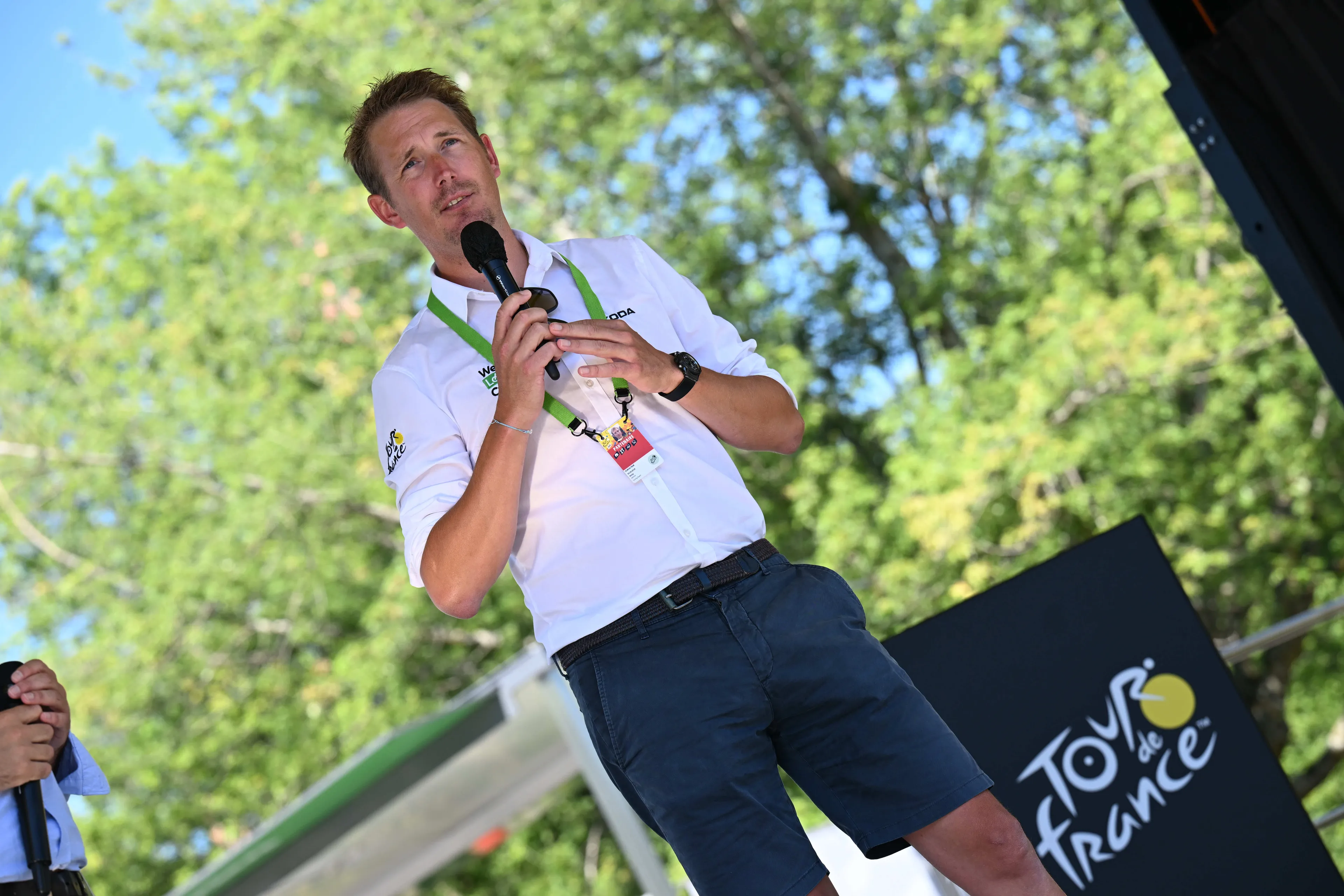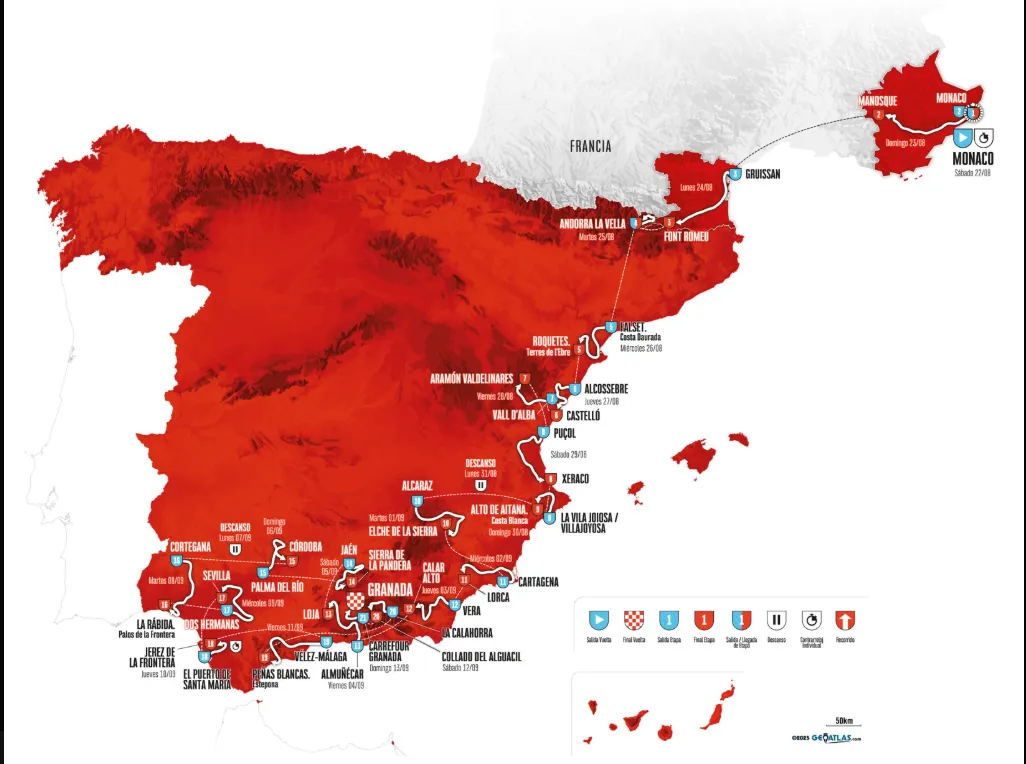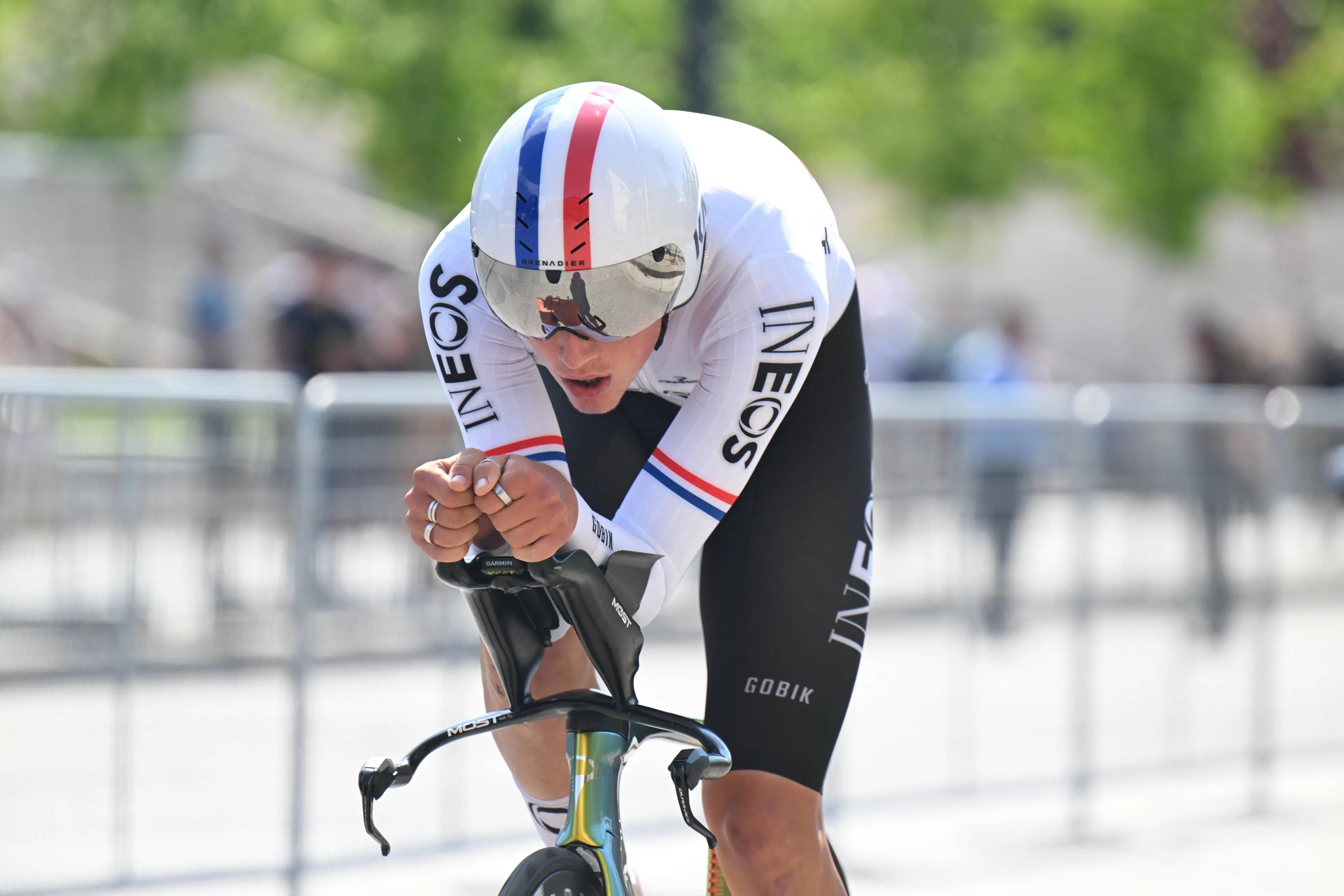Profiles & Route 2025 Giro d'Italia - 3 days in Albania, mini Strade Bianche; Finestre and Mortirolo headline mountain stages
CyclingThursday, 08 May 2025 at 10:39
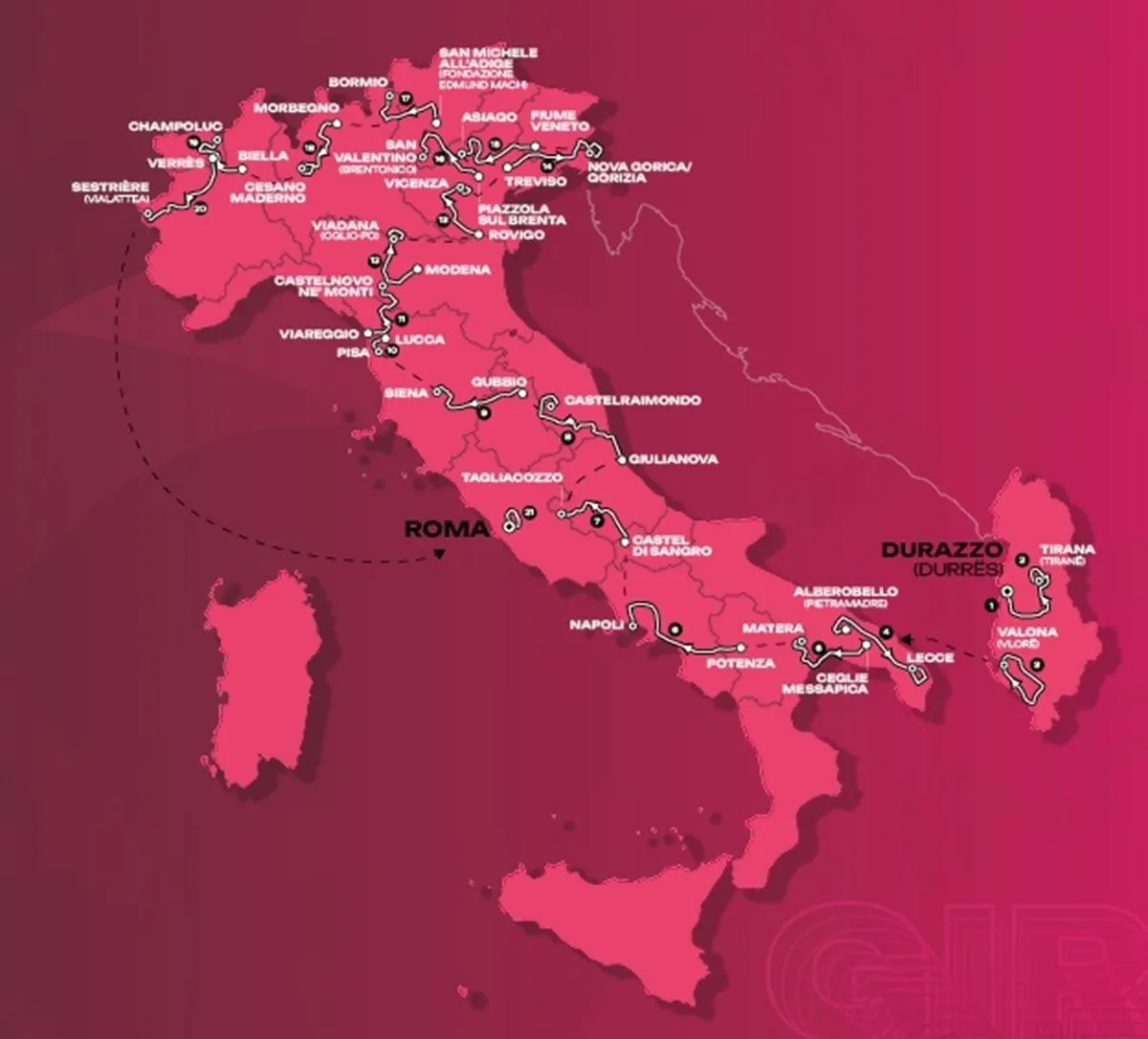
From the 9th of May to the 1st of June, the world of cycling will be glued to the screens for the first Grand Tour of the season: the Giro d'Italia. From Albania to a mini Strade-Bianche to the high Alps, the race will provide spectacle in all kinds of terrains. We take a look at it's profiles.
The route will feature it's traditional 21 stages, the first 3 of which in the eastern European nation. From there on there is a small across-the-sea journey back to Italy, where the route will slowly move north through the west coast via cities like Napoli, Siena and Pisa. In the Alps the race will be decided with a combination of mountain stages of different styles, featuring explosive days, long mountains and also high altitude.
Read also
Stage 1
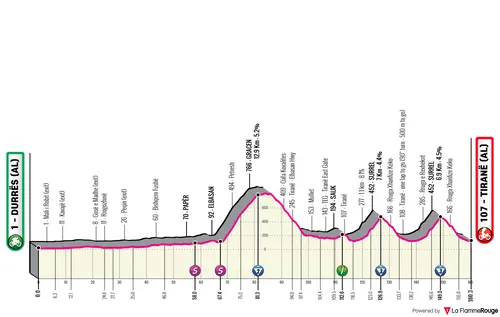
Durazzo - Tirana, 160 kilometers
The first stage of the race will take place between Durazzo and Tirana. There will be three categorized climbs, one long one in the middle of the stage and two ascents of the Surrel ascent. There will then be a downhill into the finish, a day that could potentially see many different riders succeed.
The distance is not big and the first half of the stage is completely flat. But this won't be a day for a bunch sprint, and it is one that is potentially more difficult than most opening stages of three-week races. 12.9 kilometers at 5.9% will open up the action with the climb to Gracen finishing with 79 kilometers to go. It won't likely be paced too hard, this will be reserved for the final climb which will be ridden on two occasions.
This will be the climb to Surrel which is 6.9 kilometers at 4.6%, it's an ascent that is similar to Cipressa - the distance and gradient are similar, albeit a little harder and with a 13% ramp that can be a more proper launchpad. It's not an ascent where the pure climbers can make the difference, and it is one where a sizeable peloton can go through the final summit with 11 kilometers to go.
But this doesn't mean that it will come down to a sprint fighting for victory. For the first places, with certainty, but the descent is technical and the final kilometers will be downhill almost all the way to the line, and so any attack or rider who gets a gap can get away with a very prestigious victory.
Read also
Stage 2 (ITT)
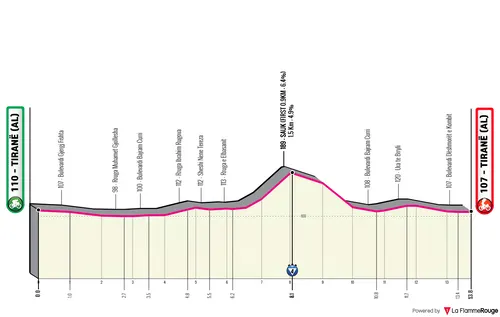
Tirana - Tirana, 13.7 kilometers
The second day of the race will be an individual time-trial and an interesting one. 13.7 kilometers in distance and it will not be flat, as in the city of Tirana there will be an explosive ascent halfway through.
The short distance means that in the fight for the stage win, any second can count, and there will be risks taken in the Albanian capital to obtain this or even the pink jersey. However it's not an effort on flat roads only, as the riders do go up a small hill where there is an intermediate point after 8.1 kilometers. It is 1.5 kilometers at 4.9%, and the riders then go down the same road at high speeds... The flat sections will have a few technical corners where the difference can be made.
Read also
Stage 3

Valona - Valona, 160 kilometers
Stage 3 is another very open day. The first half of the stage is not too difficult but there are some hard climbs on the second half that may see some GC fighting, a breakaway battle, outsider attacks or some sprinter teams trying to control the peloton as best as possible.
160 kilometers starting and finishing in the city of Vlorë (or Valona, as the Italians say). In the first half of the day there will be a 2.2-kilometer long climb at almost 10%, although at this point in the day, it will only serve to create some fatigue. Definitely, some teams will want to do damage on the climbs to eliminate a few sprinters from the battle. However this time around there is a more difficult climb to potentially make the difference.
5.1 kilometers at 6.8% with 65 kilometers to go, and it will be hilly until the base of the climb to Qafa e Llogarasë which is 10.6 kilometers long at 7.3%. Not a "brutal" mountain, but it is one where if someone fully wants to, they can make the difference - specially with the time-trial already opening up gaps the previous day. The climb will summit with 38 kilometers to go and they will then lose 1000 meters in altitude.
Only the last 17 kilometers are truly flat. Likely, a sprint between the survivors from the climb will be fighting for victory as the roads are flat and pretty simple so it's easy to organize a good chase, however the race can equally be very tactical and see an interesting fight between some GC contenders, climbers and classics specialists.
Read also
Stage 4

Alberobello - Lecce, 189 kilometers
The race returns to the mainland through Alberobello with the first pure day for the sprinters. No major difficulties into Lecce and the sprinters will with no doubt be in the spotlight on this day. With a mere 730 meters of climbing - one categorized climb on the day, and mostly flat roads all the way.
The riders head southeast towards Italy's 'heel of the boot' geographically speaking, and finish in the central city of Lecce where there will be a two-lap circuit in urban roads. The finale will be very fast and it will also be technical.
Entering the final kilometer there are two small right-hand corners which will require care and the fight for positioning into it will be big as the peloton will stretch out. And then, already in the very last few final hundred meters there is a sharp left-hand corner that will lead to a long sprint.
Read also
Stage 5

Ceglie Messapica - Matera, 151 kilometers
A short stage with a very interesting finale, where in true Giro form, the organizers leave way for multiple scenarios. The finale into Matera is slightly uphill and comes after a few hills. We could have a reduced bunch sprint or a late attack succeeding here as the peloton heads back northwest and into central Italy.
Most of the day is relatively uneventful, a transition day although one that only has 151 kilometers in distance, but it will get quite explosive towards the finale. It will kick off in the climb to Montescaglioso which is 2.9 kilometers at 8.3% and ends with 28 kilometers to go. It is the hardest ascent of the day, and the one where a few teams may push the pace to truly burn off the pure sprinters.
They may struggle later on, but the terrain will never be truly steep. The finale into Matera is always a hilly one, but features a few separate ascents. 5.6 kilometers at 4.6% with 12 kilometers to go will do some damage, but the riders descend out off town again and then go back up through some more inconsistent and explosive roads.
One small ascent finishes with 4.2 kilometers to go, then with 1.9 kilometers to go ends a 700-meter ramp at 8% (with a 10% maximum) where there can very well be a few dangerous attacks. It will be the main kick up and put many on the limit. The finale will be technical, and after a little descent the final 1.2 kilometers gently rise once again inside the city. Ultimately there will be a slightly uphill sprint, but one where the sprinters that survive will absolutely have the advantage.
Read also
Stage 6

Potenza - Napoli, 227 kilometers
Stage 6 will finish in Napoli, following the success of recent years. However, after a few hilly stages, there is a more flat approach this time around. The stage will be long, 227 kilometers in total, but the fast men have no difficulties in the final kilometers to stop them.
But this doesn't mean a sprint will happen. There are 2500 meters of climbing, all inside the final two thirds of the stage - and the distance itself will make it hard on some riders. There are four different climbs on the day that are mention worthy, including the opening 5 kilometers at 4%; a 20-kilometer long ascent and two more that finally end with 82 kilometers to go. Fatigue will matter towards the end of the day, even though a bunch sprint will likely happen.
It will be a traditional finale in a known location, so not a surprise for those who are often present in the race. There are a few nervous sections in the final kilometers but the final 1.2 are in a straight line right by the sea and so there is time to recover position and launch a textbook sprint.
Read also
Stage 7

Castel di Sangro - Tagliacozzo, 168 kilometers
Stage 7 will feature the first summit finish of the race. In the Appeninnes, the riders take off and immediately start climbing. It's not a brutal day, but it will be important to test the form of the pink jersey contenders. 7.8 kilometers at 5.8% right from the start means there should be a strong breakaway being formed.
A traditional rolling day in this area of the country, with very few flat roads. With 98 kilometers to go there is a climb which is 4.6 kilometers long at 9.2% and that is a serious ascent, which will be felt later on. Unlikely that there will be a very strong pace but the peloton will lose riders. Quickly after there is are 14 kilometers of climbing at around 5% (with a small descent in the middle) and only then can the riders relax a little before preparing for the final ascent where the GC riders will go to the limit.
The riders will be saving their legs until the final ascent to Tagliacozzo which will be just over 12 kilometers long at 5.5%. However, the final 2 kilometers average 10% and will be quite difficult. If riders do not have their best form they risk losing meaningful time and entering the key days already with a lot of pressure on their shoulders.
Read also
Stage 8

Giulianova - Castelraimondo, 197 kilometers
Stage 8 is a true Giro classic, with plenty climbs of different lengths and gradients, a day well suited to a breakaway but where a lot can happen. We have difficult ascents on this day, but will the GC riders risk it before what is one of the key stages of the race?
It's a grizzly Giro day with 3700 meters of climbing and they will be spread from start to finish, with almost 200 kilometers in distance making it an endurance challenge as well. Climbers and puncheurs could fight for a stage win from a breakaway, in the peloton it's hard to believe anyone can or will want to control such a difficult and tricky day. Most will want to keep their GC aspirations safe, save their legs towards the gravel stage, or potentially even attack in the final hilltops.
There is a major climb to note which is the ascent to Sassotetto, 13 kilometers at over 7% which ends with 91 kilometers to go. Later on, 5.5Km at 6.9% which end with 45 kilometers to go... And then two small explosive ascents before the downhill finale into Castelraimondo.
The first is 1.4 kilometers at 7.3% which summit with 20 kilometers to go and have an intermediate sprint alongside it; whilst the second has two sections, the last of which 600 meters at 8% with a finale only 6.5 kilometers from the finish which can stimulate attacks. The downhill will go all the way into the final kilometer and there is the chance to create some small differences.
Read also
Stage 9

Gubbio - Siena, 181 kilometers
Stage 9 will be one of the key moments of the race, as the riders take on a 'mini Strade Bianche'. This will be a day where the overall classification will be tested in a terrain they are not favoured in - where crashes, splits and tactics are often key. It will feature climbing and the pressure will be on so expect the pink jersey contenders to be around the front, but there will simultaneously be a lot of riders aiming for a prestigious stage win.
The riders will tackle dozens of kilometers of gravel roads (30 in total), plenty short and steep climbs and will be ending the stage in the city of Siena, which also hosts the finale of Strade Bianche, with the famous ascent of the Via Santa Caterina included.
It won't be the 'full thing' as the riders tackle in March, but it will be hard enough to create the chaos and damagte that is expected. From 68 to 34 kilometers to go it will be full high-octane racing before, between and during the gravel sectors which are not only tricky/narrow but also with a few climbs and descents all throughout it... It ends with a 1 kilometer climb of 7%.
Here the race can blow up. Later on, the fight for the stage win continues, and bigger differences can be made with direct attacks, not just the chaos, because with 14 kilometers to go the riders tackle Colle Pinzuto which is 450 meters long at 12% at the end of the sector. There is then a set of rolling roads before the well-known finale into Siena.
That's right the Piazza del Campo will be seen, the finish line will be at the location we all know which is a true privilege. The ascent to Via Santa Caterina needs no introduction, and it will be climbed inside the final kilometer right before the finish, with it's 16% ramps providing the spectacular finale for the first week of the race.
Read also
Stage 10 (ITT)

Lucca - Pisa, 28.6 kilometers
The second and final time-trial of the race, of moderate length. It will be flat, but the Giro organizers did not plan on making a traditional day against the clock. The 28 kilometers will be enough to create differences, however amongst the best things should stay relatively similar.
There isn't too much to analyze, as the roads truly are mostly flat almost from start to finish. Right before the second intermediate sprint there is a tricky descent with a few hairpins that will require some attention, but as long as they keep it upright there, then it's smooth sailing into Pisa and it's leaning tower.
Read also
Stage 11
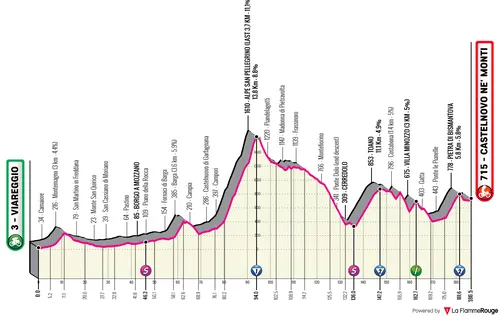
Viareggio - Castelnuovo Ne Monti, 186 kilometers
Stage 11 is a very tricky one, it can be for the GC men but it depends on their mentality. Right after the time-trial, there may be risks taken here. 3800 meters of climbing, another tricky hilly day that can turn into more with the right set of conditions.
The stage features a brutal ascent early on of the San Pellegrino in Alpe which is over 14 kilometers long at 8%, one of the hardest in the race. But if the trigger isn't pulled, then likely we have a day for the breakaway whilst the GC riders will be marking each other in the hilly finale into Castelnuovo Ne Monti.
11Km at 4.9% (39Km to go), 1.4Km at 5% (30Km to go) and 3Km at 5% (24Km to go) will set things up further, potentially in the fight for the stage win if it happens in the breakaway; but if it's in the peloton then it will be further fatigue building ahead of the final ascent.
It's not a very difficult one, but at the end of such a difficult day it won't be as easy as it looks like. 5.8 kilometers at 5.8% and it will end with a few kilometers to go. Most of the final 6 kilometers remaining on the stage are downhill and technical, but there is an uphill ramp to the line where we can still see a thrilling sprint.
Read also
Stage 12
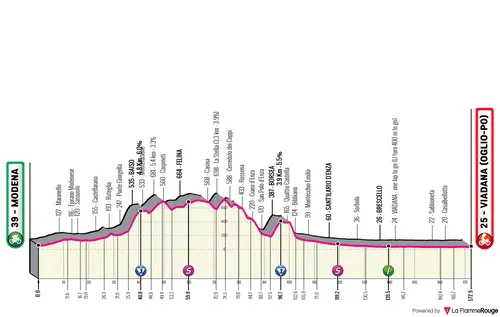
Modena - Viadana, 172 kilometers
The sprinters may have it their way once again on the 12th day of the race. From Modena to Viadana there aren't many obstacles, and it should be an important day in the fight for the Maglia Ciclamino.
There are a few climbs, this certainly isn't the pan-flat simple day the fast men hope for, but overall they are far from the finish and they aren't steep enough to create serious damage. The final hour of racing will be quite fast and simple into Viadana, although the organizers put in a nasty turn with only 350 meters to go which can make a lot of difference in the final sprint.
Read also
Stage 13
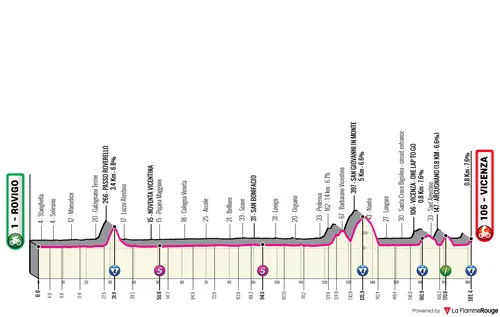
Rovigo - Vicenza (Monte Berico), 180 kilometers
On the 13th stage, the riders return to the legendary Monte Berico. A day for classics specialists, but the classification riders must also remain attentive - because although there are no long climbs on the programme, the finale certainly harbours the potential for time losses.
The stage is mostly flat, but when it goes uphill, it's steep and explosive. A perfect day for puncheurs - and possibly also for a successful breakaway group. However, the final ramp is steep enough to set the overall classification in motion. There are several climbs on the approach to Vicenza, but between them the roads are completely flat and fast - ideal for saving energy for the final kilometres.
The first crossing of Monte Berico takes place 21 kilometres before the finish. This is followed shortly afterwards by the 1.8 kilometre climb from Arcugnano with an average gradient of 6.6% - 11 kilometres before the finish. The route then descends before the riders tackle the final climb to Monte Berico, which is picturesquely situated above the town.
Although this final climb is only 800 metres long, it has an explosive effect with an 8% gradient - a purely anaerobic feat of strength that differs significantly from the previous stages and puts the legs of the favourites to a new test.
Read also
Stage 14

Treviso - Nova Gorica, 195 kilometers
The race heads abroad once again, but curiously with a day that should suit the sprinters. There is no meaningful climbing with the start in Treviso, whilst the riders climb slightly into the border with Slovenia. There should be a bunch sprint taking place in Nova Gorica later on.
The peloton heads east, mostly pan-flat, but there are a couple of kickers in the final kilometers that will make it a bit more interesting. There will be a 700-meter long climb at 7% that will be ridden on both the laps in the final circuit on the border city, and this will end with 8 kilometers on both occasions. Positioning will be key, tension will be high, and we may see attacks to try and disrupt the natural order of the stage.
Even if we see a bunch sprint, it can be quite a chaotic one due to the circuit's route. The final kilometers are quite technical and it will not be easy to organize a chase, and so next to the rain station in Nova Gorica we may see several scenarios play out.
Read also
Stage 15
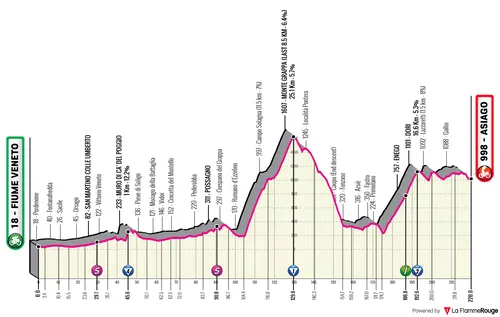
Fiume Veneto - Asiago, 219 kilometers
Giro fans will remember this finale, which hosted the finale of the final mountain day of the 2017 Giro d'Italia. A successful combo on that day, and the race directors are hoping to see similar action on the final day of the second week, featuring the fearful Monte Grappa and the climb to Dori en route to a rolling finale in Asiago.
A whole 219 kilometers on the menu means that endurance will once again become a feature, something the Tour de France organizers did not really think about. The Giro provides a lot of this challenge, which can make mountain days more interesting and with more unexpected twists. Early in the day the riders face the famous Muro di Ca' del Poggio which is extremely steep, but will be early in the day and won't serve as a platform to launch attacks.
Later on however, the climbs become very long. Not through it's most difficult side, but the riders will take on Monte Grappa, 25 kilometers long at 5.7%, a climb that will take around an hour and honestly it features gradients that are hard enough to launch serious attacks. It's the final day of the second week, will someone try? Possibly, but unlikely, as the climb still ends with 91 kilometers to go.
The descent will be long, steep and technical, and then there will be some rolling roads until the final climb to Dori. 16.6 kilometers at 5.3% makes a different challenge than some others, it's a big-ring climb where the gradients never go above 10%... It's not the typical ascent for a brutal mountain day, but in these circumstances it definitely can be enough to make the difference.
But it is the potential for tactical racing that makes this finale even more interesting. After so much climbing (this ends with 28Km to go), there is a descent and then a steep uphill ramp of 8% during 1.5 kilometers that end with 20 kilometers to go. But there never really is any big descent...
The entire finale is rolling, in a plateau road that leads to the town of Asiago and where attacks can come at all times. Away from the climbs, the GC riders will go head-to-head on terrain where they are not specialists in, and where a lot of interesting things can happen.
Read also
Stage 16

Piazzola sul Brenta - Brentonico (San Valentino), 203 kilometers
Stage 16, the first day of the final week, will be brutal. Five categorized climbs but the race should really explode on the final ascent to San Valentino, 17 kilometers long at 6.5%. There will be lots of climbing and it's a day for the pure climbers to make the difference.
The first kilometers of the over 200-kilometer long day is flat, but the last two thirds are crazy difficult, and after the last rest day there may be some more riders struggling. A bad day here can spell the end of the GC aspirations for any rider, no exceptions. 4700 meters of climbing...
12.9Km at 4.9% (130Km to go), 10.1Km at 7.5% (88Km to go) and then two climbs that are a brutality, and both can see serious GC differences depending on where the race blows up. The first of which is Santa Barbara which is 12.7 kilometers at 8.3%, a constantly steep climb that is very long. It ends with only 34 kilometers to go and the descent is steep and very technical which can also see differences.
There is virtually no space between the two ascents, and so the end of the descent is the start of the final climb to Brentonico. This will also be hard enough for serious differences, averaging 6% for 18 kilometers, and this is with two downhill sections throughout the ascent. There are several kilometers in the final half of the climb averaging 9% and this will absolutely be enough for big race-deciding attacks.
Read also
Stage 17

San Michele all'Adige - Bormio, 155 kilometers
Much had been rumoured of this stage, but an ascent of the Passo dello Stelvio will not be present. Instead Bormio hosts the finale of an interesting stage which is not as dangerous for the GC as we usually have in the city. The distances are now much shorter, a more explosive and tactical GC day...
We will have climbs of the Passo del Tonale (14.8Km; 6.2%) and the Passo del Mortirolo (but not through it's hardest side, being 12.8Km at 7.6%) that come with 86 and 48 kilometers to go. They are hard, not as hard as the previous days, but hard enough to again fully explode the GC fight. But after the summit there will still be over an hour of racing... So what follows?
First of all a major trap which is the descent of the Mortirolo, extremely steep and technical which in itself can create serious differences. Riders from the breakaway can then make serious difference depending on what happens in the peloton, and can push forward attacks both up and downhill.
The riders climb 700 meters in altitude throughout the following kilometers. But even if nothing happens until then, the final ascent of the day to Le Motte can still be used for big attacks. It's 3 kilometers long at 8%, at the end of such a stage, uphill run-in, and third week of the race, it can be ground for more big attacks from the victory contenders.
This climb ends with just a little under 10 kilometers to go, half of the run-in to the finish is flat which could still see some action, whilst the other half is slight downhill.
Read also
Stage 18

Morbegno - Cesano Maderno, 144 kilometers
Stage 18 will be the penultimate opportunity for the sprinters, however this late in the race there will be a lot of riders looking to attack the first half of the day to try and form a strong breakaway. Into Cesano Maderno, we should have a thrilling day of action amongst many riders.
There are four climbs on the day and the most difficult one is the first one, which is 7.6 kilometers long at 5.8%... If the group only goes up the road here, it can be a very strong one, and with such short distances on the day it can be quite hard to keep up a hard pace to bring them back.
The final climb ends with 56 kilometers to go, and then there is one hour of racing left into Cesano Maderno as the riders leave the lakes region and head towards the outskirts of Milano. The finale isn't too technical and it is completely flat.
Read also
Stage 19
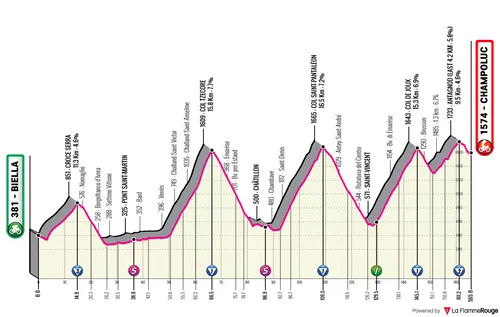
Biella - Champoluc, 166 kilometers
Stage 19 will take place in the Valle d'Aosta and truly it will feature what the region has the most, technical climbs and descents, all of them long and steep but very similar in it's characteristics. It's trully a very difficult day with climbing right from the start, but then also three very long and difficult ascents on the Col Tzecore, Col de Saint Pantaleon and finally Col de Joux, each of them 16 kilometers in length and averaging around 7%. A day of endurance and where in the final week huge differences can be created.
Right at the start of the day there is an 11-kilometer long climb at 4.65 which starts after only 3 kilometers of racing. A lot can happen here, and the GC teams will want to send riders up the road before entering the brutal terrain. Tzecore ends with 99 kilometers to go, Saint-Pantaléon ends with 56 kilometers to go (the first descent extremely technical, the second extremely fast in it's majority).
Then comes the Col de Joux which, because it's the last of the difficult ascents, should see the main attacks. 15.1 kilometers at 6.9% will be a proper ascent to split the entire race and the climb ends with 20 kilometers to go.
Before arriving in Champoluc however there will still be another small ascent to Antagnod, one that has nothing to do with the previous ascents, but will prolong the spectacle and who knows, perhaps even create further differences at a point of the stage where most will already be on their knees. The climb is 9.5 kilometers long at 4.6%, but the second half has ramps going up to 11%. The climb ends with 4.6 kilometers to go before the downhill finish.
Read also
Stage 20
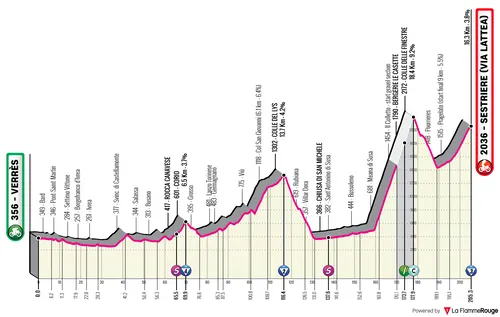
Verres - Sestriere, 205 kilometers
The queen stage? Many will say that exactly, it's a day with an easy start but the Giro organizers have saved the best for last. In 2018 over these climbs we saw the race turned on it's head as pink jersey Simon Yates cracked and Chris Froome stormed to the race lead with a huge solo attack. It doesn't look like it, as a lot of the stage looks flat, but there are 4400 meters of climbing, and it's a truly devastating finale to the race.
The riders climb the Collle del Lys with 90 kilometers to go, and by this point some teams can truly set up attacks for later on, and drain the legs of their rivals through these rolling roads. Riders have seen what is possible as in 2018 the pink jersey himself crumbled completely, and so we know anything can happen.
Because then comes the insanely difficult Colle delle Finestre, an hour-long ascent which averages 9% for over 18 kilometers, 7 of which in gravel. It's going to decimate the peloton this late in the race. There's nowhere to hide, you need your very best level on this climb, or you can lose minutes. If that wasn't hard enough, the climb ends with still 28 kilometers to go.
The final climb to Sestriere then will be 16 kilometers long, the first half very gentle and on false-flat roads, but the final 10 kilometers average 5%... At altitude, after Finèstre and on stage 20, this may end up becoming one of the hardest ascents of the race, and will create the final overall classification differences.
Read also
Stage 21

Roma - Roma, 143 kilometers
The race will finish with a flat stage in Rome, 143 kilometers with the sprinters having their final shot at glory. It's a day of celebration as the riders finally reach the end of the race and can enjoy a short and flat day around the capital, with the final circuit fitting the sprinters.
The circuit will be rather fast, a little technical at times, but we will without a doubt see a bunch sprint next to the Circo Massimo.
Read also
claps 2visitors 2
Just in
Popular news
Latest comments
- I dont know about winning but he has certainly shown that he can lose one.abstractengineer19-12-2025
- Unfair points system!!!. Its the same system under which Virenque won 7 polka dots. But then he cheats so how can he call it unfair.abstractengineer19-12-2025
- Yes being favorites, being 3 to 1 and not winning is worst, 2nd time in history, both times Belgiansabstractengineer19-12-2025
- Uijtdebroeks is just a malcontent. he has never won anything. he will do nothing with Movistar. I would let Remco go for 7 million too. he's great, but not worth it. pay 10 million for Ayuso? also nuts.mij19-12-2025
- interesting Mads got 2nd at Flanders, and he isn't even mentioned by Wout LOL. makes me laugh how he is so overlooked.mij19-12-2025
- I think a 3 v 1 finish with the 1 being a good rider, but not great, is close to humiliation.mij19-12-2025
- These whiners simply want to keep their hold in the highest echelons of the sport without having to perform well enough to please their sponsors and remain there. Cycling has been "unsustainable" ...for 130 years! If Vaughters wants to leave the sport, there will be hundreds of teams happy to ride the Tour and the biggest races in the world in his place. That's what happens when there's a ton of supply of teams and a limited amount of demand for teams at the highest level! -An Economistacem8219-12-2025
- If she was Dutch or Belgian she'd have already sorted a team out. Unfortunately, the CX teams are pretty insular to 'foreigners' and would rather give a spot to a local rider. And that is one reason why the sport is niche outside its heartland.wipperman9519-12-2025
- Dear Editor: It is no humiliation to make the final, even with two riders, and not get it perfect against another talented rider. Disappointment, sure.itsent18-12-2025
- I luv this guy ,so honest puts the hand up ..."my fault.".. I would be stoked to see him win his big monuments ... i think he would be a great team mate and friend.Davide18-12-2025
Loading
Write a comment
